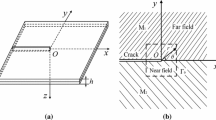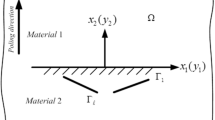Abstract
The fracture behaviors near the mode II interface crack tip for orthotropic bimaterial are studied. The non-oscillatory field, where the stress singularity exponent is a real number, is discussed by the complex function method and the undetermined coefficient method. From the research fracture problems, the stress functions with ten undetermined coefficients and an unknown singularity exponent are introduced when Δ1 > 0 and Δ2 > 0. By the existence theorem of non-trival solutions for the system of eight homogeneous linear equations, the characteristic equation, the stress singularity exponent, and the discriminating condition of the non-oscillatory singularity are found. By the uniqueness theorem of the solutions for the system of twelve non-homogeneous linear equations with ten unknowns, the ten undermined coefficients in the stress functions are uniquely determined. The definitions of the stress intensity factors are given with the help of one-sided limit, and their theoretical formulae are deduced. The analytic solutions of the stresses near the mode II interface crack tip are derived. The classical results for orthotropic material are obtained.
Similar content being viewed by others
References
Williams, M. L. The stresses around a fault or crack in dissimilar media. Bulletin of the Seismological Society of America, 49, 199–204 (1959)
Sih, G. C. Stress distribution near internal crack tips for longitudinal shear. Journal of Applied Mechanics, 32, 51–58 (1965)
England, A. H. A crack between dissimilar media. Journal of Applied Mechanics, 32, 400–402 (1965)
Erdogan, F. Stress distribution in bonded dissimilar materials with cracks. Journal of Applied Mechanics, 32(3), 403–410 (1965)
Rice, J. R. and Sih, G. C. Plane problems of crack in dissimilar media. Journal of Applied Mechanics, 32, 418–423 (1965)
Lin, K. Y. and Mar, J. W. Finite element analysis of stress intensity factors for cracks at a bi-material interface. International Journal of Fracture, 12, 521–531 (1976)
Sun, C. T. and Jih, C. J. On stain energy release rates for interfactal cracks in bi-material media. Engineering Facture Mechanics, 28, 13–20 (1987)
Ma, K. P. and Liu, C. T. Semi-weight function on computation of stress intensity factors in dissimilar materials. Applied Mathematics and Mechanics (English Edition), 25(11), 1241–1248 (2004) DOI 10.1007/BF02438279
Marsavina, L. and Sadowski, T. Stress intensity factors for an interface kinked crack in a bimaterial plate loaded normal to the interfaces. International Journal of Fracture, 145, 237–243 (2007)
Chen, Y., Qiao, P. Z., Jiang, H. D., and Ren, Q.W. Review on experimental methods and fracture models for bi-material interfaces (in Chinese). Advances in Mechanics, 38, 53–61 (2008)
Li, C., Tie, Y., and Zheng, Y. P. Influence of material characters on bimaterial interfacial crack energy release retes and stress intensity factors (in Chinese). Journal of Mechanical Engineering, 45, 104–108 (2009)
Liu, Y. H., Wu, Z. G., Liang, Y. C., and Liu, X. M. Numerical methods for determination of stress intensity factors of singular stress field. Engineering Fracture Mechanics, 75, 4793–4803 (2008)
Chang, J. and Xu, J. Q. The singular stress field and stress intensity factors of a crack terminating at a bimaterial interface. International Journal of Mechanical Sciences, 49, 888–897 (2007)
Dai, Y. and Ji, X. Researches on stress singulality of interface end and distributive law of interface stress (in Chinese). Science China, Physics, Mechanics & Astronomy, 37, 535–543 (2007)
Zhang, A. B. and Wang, B. L. An opportunistic analysis of the interface crack based on the modified interface dislocation method. International Journal of Solids and Structure, 50, 15–20 (2013)
Comininou, M. The interface crack. Journal of Applied Mechanics, 44, 631–637 (1977)
Dundurs, J. and Gautesen, A. K. An oppportunistic analysis of the interface crack. International Journal of Fracture, 36, 151–159 (1988)
Delale, F. and Erdogan, F. On the mechanical modeling of the interface region in bonded halfplane. Journal of Applied Mechanics, 55, 317–324 (1988)
Zhou, Z. G. and Wang, B. Investigation of the behavior of a Griffith crack at the interface between two dissimilar orthotropic elastic half-planes for the opening crack mode. Applied Mathematics and Mechanics (English Edition), 25(7), 730–740 (2004) DOI 10.1007/BF02437564
Li, J. L., Zhang, S. Q., and Yang, W. Y. Stress field near interface crack tip of double dissimilar orthotropic composite materials. Applied Mathematics and Mechanics (English Edition), 29(8), 1045–1051 (2008) DOI 10.1007/s10483-008-0808-7
Wu, Z. G. and Liu, Y. H. Asymptotic fields near an interface corner in orthotropic bi-materials. International Journal of Fracture, 156, 37–51 (2009)
Yang, W. Y., Zhang, S. Q., Li, J. L., and Zhang, X. X. Interface crack problem for mode II of double dissimilar orthotropic composite materials. Applied Mathematics and Mechanics (English Edition), 30(5), 585–594 (2009) DOI 10.1007/s10483-009-1202-4
Zhang, X. X., Cui, X. C., Yang, W. Y., and Li, J. L. Crack-tip field on mode II interface crack of double dissimilar orthotropic composite materials. Applied Mathematics and Mechanics (English Edition), 30(12), 1489–1504 (2009) DOI 10.1007/s10483-009-1202-4
Yang, X. M., Yang, W. Y., Li, J. L., and Zhang, X. X. Fracture analysis near the interface crack tip for mode I of orthotropic biomaterial. Science China Physics, Mechanics and Astronomy, 56, 785–797 (2013)
Suo, Z. Singularities, interfaces and cracks in dissimilar anisotropic media. Proceedings of the Royal Society of London, Series A, Mathematical and Physical Sciences, 427, 331–358 (1990)
Zhang, X. S. A central crack at the interface between two different orthotropic media for the mode I and mode II. Engineering Fracture Mechanics, 32, 327–333 (1989)
Erdogan, F. and Wu, B. H. Interface crack problems in layered orthotropic materials. Journal of the Mechanics and Physics of Solids, 41, 889–917 (1993)
Gao, H., Abbudi, M., and Barnett, D. M. Interfacial crack-tip field in anisotropic elastic solids. Journal of the Mechanics and Physics of Solids, 40, 393–416 (1992)
Lekhnitskii, S. G. Theory of Elasticity of an Anisotropic Elastic Body (in Chinese), Science Press, Beijing, 1–33 (1963)
Sih, G. C. and Liebowitz, H. Mathematical theories of brittle fracture. Mathematical Fundamentals of Fracture, Academic Press, New York, 89–131 (1971)
Corten, H. T. Fracture mechanics of composites. Fracture of Nonmetals and Composites, Academic Press, New York, 675–769 (1972)
Sih, G. C. and Chen, E. P. Cracks in composite materials. Mechanics of Fracture, 7, 113–115 (1981)
Yang, W. Y., Li, J. L., and Zhang, X. X. Method of a Complex Variable for Fracture in Composite Materials (in Chinese), Science Press, Beijing (2005)
Yang, W. Y. and Zhang, S. Q. The analysis about the stress field near model I crack tip in composite material (in Chinese). Journal of Taiyuan Heavy Mechinery Institute, 7, 46–53 (1986)
Yu, J. R. Function of a Complex Variable (in Chinese), People Education Press, Beijing (1979)
Ren, B. S. Advanced Algebra (in Chinese), Advanced Education Press, Beijing (2002)
Baldi, A. Full field methods and residual stress analysis in orthotropic material, II: nonlinear approach. International Journal of Solids and Structures, 44, 8244–8258 (2007)
Zhang, S. Q. and Yang, W. Y. Prediction of mode I crack propagation direction in carbor-fiber reinforced composite plate. Applied Mathematics and Mechanics (English Edition), 25(6), 714–722 (2004) DOI 10.1007/BF02438215
Author information
Authors and Affiliations
Corresponding author
Additional information
Project supported by the Natural Science Foundation of Shanxi Province (No. 2014011009-2)
Rights and permissions
About this article
Cite this article
Yang, T., Yang, W., Li, J. et al. Analysis on non-oscillatory singularity behaviors of mode II interface crack tip in orthotropic bimaterial. Appl. Math. Mech.-Engl. Ed. 37, 1177–1192 (2016). https://doi.org/10.1007/s10483-016-2123-6
Received:
Revised:
Published:
Issue Date:
DOI: https://doi.org/10.1007/s10483-016-2123-6




